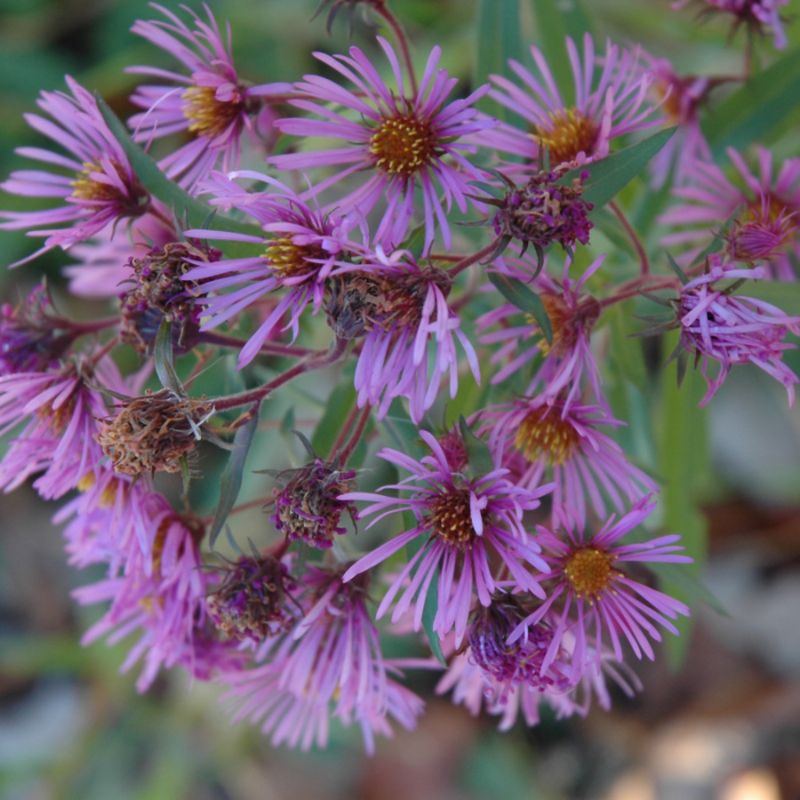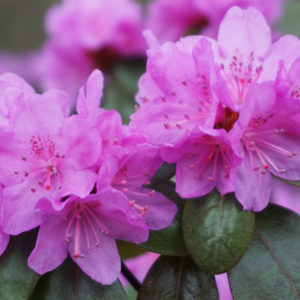Asters are a wonderful group of plants for fall. Between the 100+ different species native to the U.S. along with their many cultivars it is possible to have swaths of color abuzz with bees and other pollinators as the growing season winds down. Not all native asters are adapted to New England, but we are home to two of the most popular groups of asters: New England and New York.
New England asters, Symphyotricum novae-angliae, as a species are 3-4’ tall with rough, hairy foliage and deep reddish-purple flowers. They need full sun and moist free-draining soil. Like many of the taller growing asters, they can benefit from being cut back in mid-summer to induce sturdier growth.

Cultivars of this aster have expanded the choice of flower color, improved disease resistance and reduced the need for staking. A couple of common options include:
S. novae-angliae Purple Dome is a wonderful compact variety, living up to its name perfectly as it tops out at 2’ tall and wide. Great for the front of the border.
S.novae-angliae Grape Crush is another floriferous compact nativar having vibrant purple flowers, while Pink Crush is covered with deep shocking pink flowers.
New York asters (S. novi belgii) are similar to New England asters, albeit a little shorter with smooth foliage and stems and flowers that can range in color from white, pink to purple, although purple is the most common variant. Happiest in consistently moist soil, they bloom in late September and is the variety that is also known as Michaelmas daisy. It too has cultivars which include:
S. novi-belgii Professor Kippenberg is a soft lavender colored cultivar that is around 2’ tall.
S. novi-belgii Hazy is a deep pink cultivar, growing around 20” tall.
However, gardeners in the north-east don’t have to confine themselves to these two stalwarts. A visit to our garden centers at this time of year offers a selection of equally pretty natives and nativars which can provide color in flower beds or meadows alike.
S. ericoides, heath aster is a compact native that grows in dry conditions and is also adapted to poor soil. Reaching between 1-3′ tall it produces white flowers. The cultivar Snow Flurry is a prostrate version that reaches around 8” tall and 12” wide. This is one for the front of the border.
S. laeve, smooth aster, has smooth stems and leaves as its common name suggests. Reaching 2-4′ tall it has bright lavender flowers. It too will tolerate dry conditions once established and is suited for sun and partial shade. A common nativar of this species is S. laeve Bluebird, which gets a little taller than the species with larger violet-blue flowers.
Eurybia divaricata, white wood aster, is for those who garden with shade. This delicate, white-flowered aster can be found at our woods’ edges and produces a mound of flowers on plants 1-2′ tall.
And lastly, my favorite among asters, not least because like white wood aster it might just appear in your yard one year, is S. cordifolium – blue wood or heart leaf aster which grows to about 3’ tall and will be a mass of tiny lavender blue flowers. It will tolerate dry soil as well as some shade but prefers average soil moisture and sun.
All asters are attractive to pollinators, and native species are often host plants of various butterflies. Species tend to grow taller than cultivars and often benefit from being cut back mid-summer to promote sturdier growth. Similarly, some can be susceptible to powdery mildew, but nativars are bred for disease resistance. When paired with plants like rudbeckia, gaillardia and echinacea it is possible to paint a vibrant palate of fall color.
Sources:
Symphyotrichum novae-angliae – Plant Finder (missouribotanicalgarden.org)
Symphyotrichum laeve (Smooth Aster, Smooth Blue Aster) | North Carolina Extension Gardener Plant Toolbox (ncsu.edu)
Eurybia divaricata – Plant Finder (missouribotanicalgarden.org)








